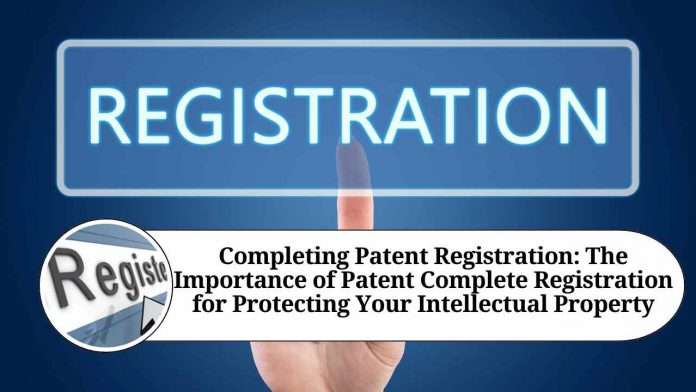Patent registration is an important step for inventors and companies seeking to protect their intellectual property. It involves filing an application with the relevant patent office and completing a series of requirements before the patent is granted. Once the patent is granted, it is important to ensure that the registration is complete to fully protect your rights. In this blog post, we will discuss the steps involved in patent complete registration.
What is Patent Complete Registration?
Patent complete registration refers to the final step in the patent registration process, where the patent owner must fulfill certain requirements to ensure that their patent is fully protected. This includes payment of any fees or maintenance costs, responding to any objections or challenges, and complying with any other formalities required by the relevant patent office.
Steps for Patent Complete Registration
The steps involved in patent complete registration can vary depending on the country or region where the patent is being registered. However, there are some common requirements that must be fulfilled:
- Payment of Fees: The patent owner must pay any outstanding fees to the relevant patent office. These fees can include application fees, examination fees, and maintenance fees. Failure to pay these fees can result in the patent being deemed abandoned.
- Response to Objections: If the patent office has raised any objections or challenges to the patent application, the patent owner must respond to them within the specified time frame. This can involve providing additional information or evidence to support the patent application.
- Compliance with Formalities: The patent owner must comply with any formalities required by the patent office. This can include providing translations of the patent documents, submitting the required drawings or diagrams, or signing any necessary documents.
- Issuance of Patent Certificate: Once all the requirements have been fulfilled, the patent office will issue a patent certificate to the patent owner. This certificate confirms that the patent has been granted and is now fully registered.
Benefits of Patent Complete Registration
Completing the patent registration process ensures that your intellectual property is fully protected. This can provide several benefits, including:
- Legal Protection: Once the patent is fully registered, the patent owner has the legal right to prevent others from using, selling, or manufacturing the invention without their permission.
- Licensing Opportunities: A fully registered patent can be licensed to others for use or manufacture. This can provide a valuable source of income for the patent owner.
- Increased Value: A fully registered patent can increase the value of a company or invention, making it more attractive to potential investors or buyers.
Conclusion
Patent complete registration is an essential step in the patent registration process. It involves fulfilling certain requirements to ensure that the patent is fully protected and legally enforceable. By completing this process, patent owners can enjoy the benefits of legal protection, licensing opportunities, and increased value for their invention or company. If you are considering patent registration, it is important to work with an experienced patent attorney who can guide you through the process and ensure that your patent is fully registered.
Other Related Blogs: Section 144B Income Tax Act
Frequently Asked Questions (FAQs)
Q: What is patent complete registration?
A: Patent complete registration is the final step in the patent registration process. It involves fulfilling certain requirements to ensure that the patent is fully protected and legally enforceable.
Q: What are the requirements for patent complete registration?
A: The requirements for patent complete registration can vary depending on the country or region where the patent is being registered. However, common requirements include payment of any fees or maintenance costs, responding to any objections or challenges, and complying with any other formalities required by the relevant patent office.
Q: What happens if I don’t complete patent registration?
A: If you do not complete patent registration, your patent may be deemed abandoned. This means that you will lose your legal rights to the invention, and others may be able to use or manufacture it without your permission.
Q: Can I complete patent registration myself, or do I need a patent attorney?
A: While it is possible to complete patent registration yourself, it is highly recommended to work with an experienced patent attorney. A patent attorney can guide you through the process, ensure that all requirements are fulfilled, and help you avoid common mistakes that could jeopardize your patent.
Q: How long does patent complete registration take?
A: The time required for patent complete registration can vary depending on the country or region where the patent is being registered, as well as the complexity of the patent application. In some cases, it can take several months or even years to complete patent registration.
Q: What are the benefits of patent complete registration?
A: Completing patent registration ensures that your intellectual property is fully protected and legally enforceable. This can provide several benefits, including legal protection, licensing opportunities, and increased value for your invention or company.
Q: Can I still make changes to my patent after completing registration?
A: Once patent registration is complete, it may be difficult or impossible to make changes to the patent. However, if the patent has not yet been granted, it may be possible to make amendments or corrections to the patent application. It is important to work with a patent attorney if you need to make changes to your patent application.




















